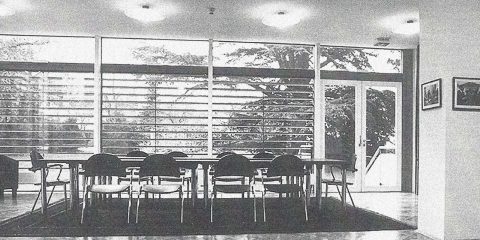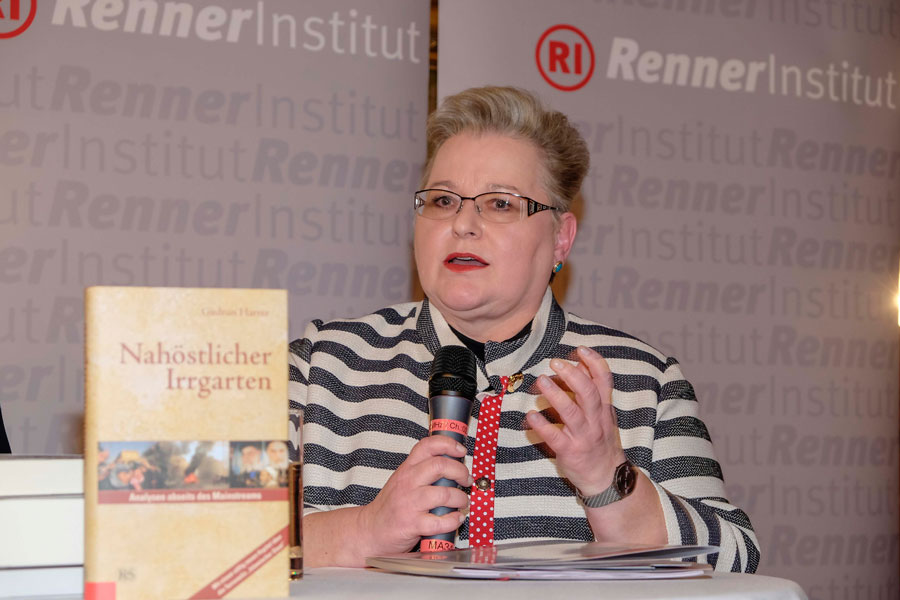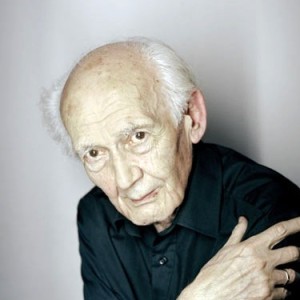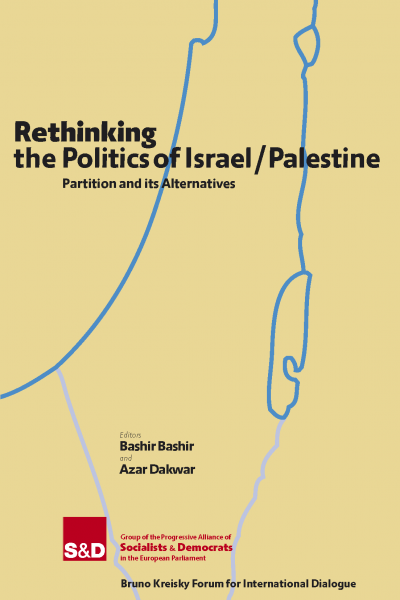Bruno Kreisky Preise für das politische Buch 2014
Der Bruno-Kreisky-Preis für das Politische Buch wird jährlich vom Karl-Renner-Institut in Zusammenarbeit mit der sozialdemokratischen Bildungsorganisation verliehen. Mit diesem Preis wird im Sinne des Lebenswerks Bruno Kreiskys politische Literatur geehrt, die für Freiheit, Gleichheit, soziale Gerechtigkeit, Solidarität und Toleranz einsteht. Neben dem Hauptpreis werden auch Preise für ein publizistisches Gesamtwerk, Anerkennungspreise und ein Verlagspreis vergeben.
Die PreisträgerInnen 2014 im Überblick:
Hauptpreis für das Politische Buch 2014:
Najem Wali „Bagdad Marlboro“, Carl Hanser Verlag, 2014.
Preis für das publizistische Gesamtwerk: Gudrun Harrer
Die international anerkannte Nahostexpertin wird im Rahmen des Bruno-Kreisky-Preises für ihre fundierte Publikationstätigkeit als Autorin und Journalistin, mit der sie maßgeblich zum Verstehen der Geschehnisse im arabischen Raum beiträgt, ausgezeichnet.
Anerkennungspreise:
Peter Ulrich Lehner: „Verfolgung, Widerstand und Freiheitskampf in Hernals. Ereignisse, Gestalten, Orte, Spuren in einem Wiener ArbeiterInnenbezirk.“, Mandelbaum Verlag, 2014.
Johann Skocek: „Mister Austria. Das Leben des Klubsekretärs Norbert Lopper. Fußballer. KZ-Häftling. Weltbürger“, Falter Verlag, 2014.
Preis für besondere verlegerische Leistungen:
Als Spezialist für Literatur aus dem europäischen Osten wird der Kärntner Wieser Verlag mit dem Preis für besondere verlegerische Leistungen 2014 ausgezeichnet.
Die Verleihung fand am 9. März 2015 im Wiener Rathaus statt. Lesen Sie im Folgenden die Festreden.
Laudatio von Hannes Swoboda (Juryvorsitzender) zum Hauptpreis
NAJEM WALI : BAGDAD MARLBORO
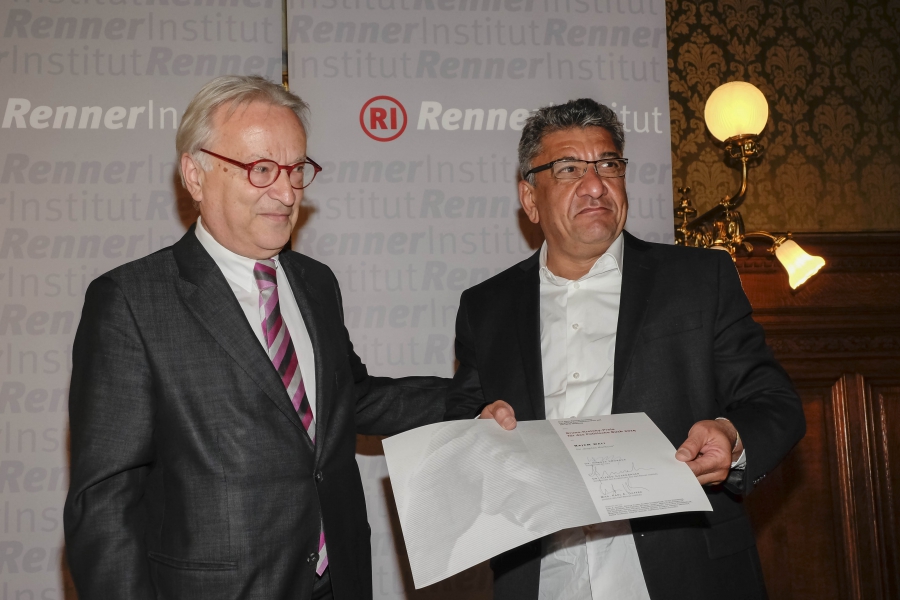 ©Peter Henisch
©Peter Henisch
Zu Beginn seines Werkes zitiert Najem Wali – in programmatischer Absicht – Italo Calvino aus dem Werk : „Die unsichtbaren Städte“: Angesichts der Hölle, gibt es nur „zwei Arten, nicht unter ihr zu leiden. Die erste fällt vielen leicht: die Hölle zu akzeptieren und so sehr Teil von ihr zu werden, dass man sie nicht mehr sieht. Die zweite ist riskant und verlangt ständige Aufmerksamkeit und Lernbereitschaft : zu suchen und erkennen zu lernen, wer und was inmitten der Hölle nicht Hölle ist, und ihm Dauer und Raum zu geben.“
Das klingt etwas optimistischer als das Diktum von Adorno aus den Minima Moralia:
„Es gibt kein richtiges Leben im falschen.“ Es entspricht allerdings einem anderen Gebot, ebenfalls von Adorno, wenn er meint: „Die fast unlösbare Aufgabe besteht darin, weder von der Macht der anderen, noch von der eigenen Ohnmacht sich dumm machen zu lassen“!
Gerade darum geht es Najem Wali: wie kann man in der Hölle als Mensch bestehen?
Einerseits geht es um die Hölle, in der die verschiedenen „Frankensteins“ (Saddam Hussein, Ghadafi etc.), wie sie Najem Wali in einem Interview bezeichnete, herrschen. Und dann geht es um die Hölle des Chaos, nachdem diese „Frankensteins“ durch Militärinterventionen von außen gestürzt werden.
Diese Verquickung der verschiedenen Gewaltstrukturen kommt in der, wie Nadjem Wali selbst sagt, verschachtelteren Geschichte zum Ausdruck. Das Töten und Getötet werden ist überall und verstärkt sich gegenseitig: „In diesem Land musste ich wählen zwischen der Rolle des Mörders und der des Ermordeten.“
Und wenn man sich nicht zwischen den beiden entscheiden kann, weil man sich für beides nicht geeignet oder bereit fühlte, dann blieb einem nichts anderes übrig als wegzugehen aus diesem „Schlachthaus“, es blieb einem nur die Flucht.
Und das ist auch, was Najem Wali selbst tun musste: seine Heimat verlassen und nach Deutschland gehen. Ob es sich um den Krieg zwischen dem Irak und dem Iran handelte – der Westen stand hier auf der Seite von Saddam Hussein(!) – oder die beiden Irakkriege: immer war die Gewalt mitverursacht oder mitgetragen von den USA und einigen der amerikanischen Verbündeten aus Europa.
Man sollte diese Verwicklung des “ Westens „nie vergessen . Und seine Mitschuld an den terroristischen Untaten, denen wir gerade dieser Tage wieder gegenüberstehen.“
Aber es sind nicht nur diese generellen Entwicklungen, die Najem Wali beleuchtet, es sind auch die individuellen, persönlichen Konsequenzen, die diese Gewaltausübung mit sich bringen: „Sie haben meine Würde und meine Menschlichkeit kaputtgemacht. Ich fühlte mich so gemein. Ich begann, wie ein Hund zu leben, dessen einzige Sorge es ist, nicht mehr gequält zu werden.“
Das waren die Auswirkungen der Folterungen in den Gefängnissen von Saddam Hussein. Oder aber auch die Konsequenzen der Folgerungen in Gefängnissen wie Abu Ghraib. Und das gilt auch für die Milizen, die aus dem Chaos entstanden und immer wieder von neuem entstehen.
Das hängt auch damit zusammen, dass es nicht nur Soldaten gibt, die sich darauf beschränken ihre „Pflicht bestmöglich zu erfüllen. Es gibt leider auch Soldaten, die sich nicht damit begnügen: „Kurz gesagt, hier handelt es sich um Soldaten, die mit Gott wetteifern, wenn sie sich nicht gar selbst an dessen Stelle setzen“! Das sind jene, die den Leitspruch verfolgen: „search and destroy“!
Das ist jene Art von Soldat, dessen Mut „sich an der Anzahl von Feinden bemisst, die durch seine Hand den Tod fanden – der Frieden ist für ihn eine Art langsamer Selbstmord.“ Er braucht den Krieg, um sich zu beweisen.
Von diesen Soldaten und von dieser Einstellung ist es dann nicht mehr weit bis zu den Milizen und terroristischen Organisationen, die täglich Gott für sich in Anspruch nehmen und ihn als Richter nicht nur anrufen, sondern ihn ersetzen und Menschen grausam ermorden. Diese terroristischen Gruppierungen entstehen ja nicht aus dem Nichts, sondern aus dem Chaos, das aus dem Sturz der „Frankensteins“ und den ausländischen Interventionen entsteht. Und Waffen sind genug im Umlauf, auch österreichische Glocks finden eine Rolle im Roman von Najem Wali.
Wie gesagt, bei „Bagdad Marlboro“ handelt es sich um einen Roman mit verschachtelten Geschichten. Aber die Geschichten dieses spannenden Romans machen deutlicher als viele historischen und politischen Analysen wie die unseligen Verknüpfungen der Geschichte innerhalb dieser Region einerseits und der Region mit den USA und Europa anderseits ins Chaos und zu Gewalttätigkeiten führten.
Gewalt kommt aus dieser Region, wurde aber auch ganz wesentlich in diese Region hineingetragen – in den Zeiten des Kolonialismus, aber noch bis heute.
Und Vielen an diesem Chaos und der Gewalt mitschuldigen wurde nie ein Prozess gemacht.
In seiner „Abrundung“ zu seinem Roman verweist Wali auf den Prozess gegen Bradley Manning, der wegen Verrats angeklagt wurde, „während die echten Mörder in ihren schmucken Büros im Pentagon oder im Weißen Haus sitzen“.
Vielleicht würde sie ein wenig das Gewissen plagen, sowie einer Hauptfigur des Romans, Daniel Brooks, würden sie Bagdad Marlboro lesen. Zumindest eine Mitschuld sollten sie empfinden, aber vielleicht ist das schon zu viel verlangt.
Ihnen allen, die Sie das Buch noch nicht gelesen haben, empfehle ich es wärmsten und Ihnen, Najem Wali, danke ich sehr herzlich für Ihr Werk. Es ist manchmal sehr deprimierend zu lesen, aber ich jedenfalls habe doch einen Schimmer Hoffnung auf Menschlichkeit und Anstand herausgelesen.
Und vielleicht gibt es doch auch im falschen Leben ein Stück richtiges, einen Schimmer an Liebe und Hoffnung, auch in der Hölle. Aber noch besser wäre es, könnten wir vermeiden, immer neue Höllen zu erzeugen. Es gäbe auch so genug Stoff für Romane. Aber bis dahin freuen wir uns, dass es Autoren wie Najem Wali gibt, die uns – wenn auch ein klein wenig – Hoffnung geben.
Laudatio von Bernd R. Fragner für das publizistische Gesamtwerk: Gudrun Harrer
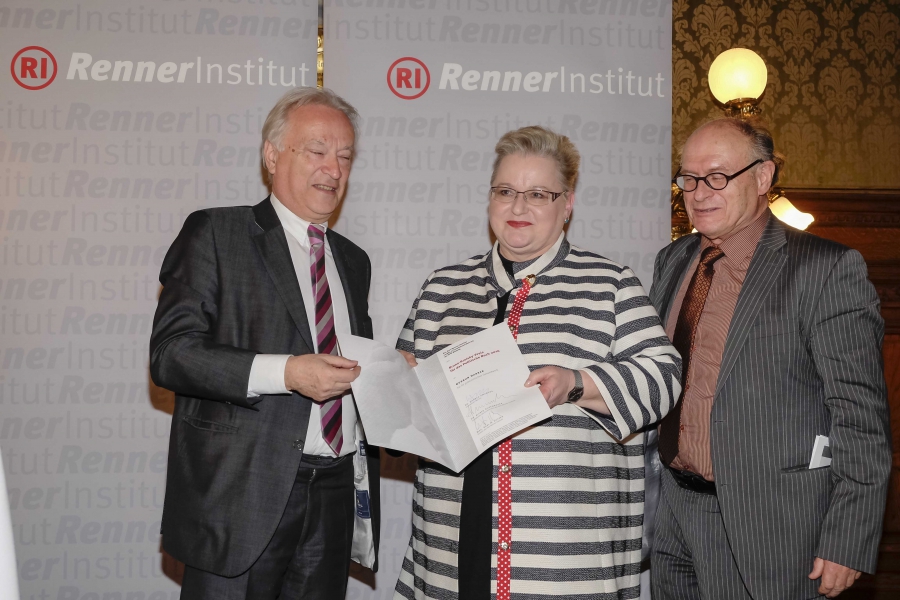 ©Peter Henisch
©Peter Henisch
Es war vor etwa 20 oder 22 Jahren, als ich zum ersten Mal von Gudrun Harrer hörte bzw. las: Ich war damals schon eine Reihe von Jahren als Hochschullehrer an der Universität Bamberg, genauer gesagt am damals noch so genannten „Institut für Orientalistik“ derselben, tätig. Einer unserer damaligen Doktoranden hatte kurz davor zwei Semester an der Universität Wien studiert, und irgendwann hängte er einen Ausschnitt aus der österreichischen Tageszeitung „Der Standard“ an das Schwarze Brett – es handelte sich um einen Artikel, der mit Gudrun Harrer gezeichnet war. Ich muss gestehen, ich weiß nicht mehr, worum es darin tatsächlich ging. Der Artikel war so auffällig gut und interessant, dass er mir gegenüber den Produkten der in Deutschland gängigen Vorderer Orient-Journalisten deutlich auffiel. Der alsbald von mir befragte Afficheur erzählte mir dann mit leuchtenden Augen von einer ganz besonderen, ja außergewöhnlichen Nah- und Mittelost-Spezialistin, die in dem bis dahin von mir, außerhalb Österreichs lebend, nur kursorisch wahrgenommenen Presseorgan „Der Standard“ regelmäßig die Ereignisse in „unserer“ Region auf eindrucksvolle Weise analysiere und kommentiere.
Ein oder zwei Jahre später war ich zu einer spätabendlichen Podiumsdiskussion in den ORF eingeladen worden – Vertreter unterschiedlicher Konfessionen hatten sich zum Dialog getroffen, und zwei Außenstehende sollten das Geschehen diskursiv begleiten – neben meiner Wenigkeit eben auch Gudrun Harrer, der ich auf diese Weise zum ersten Mal ansichtig wurde. Das war ein wichtiger Schritt für uns beide, denn nun konnten wir mit dem Namen des jeweiligen Anderen auch ein Gesicht verbinden. 2003 kamen nach vielen Jahren in Deutschland meine Frau und ich eher unverhofft nach Wien zurück, und nun ging es Schlag auf Schlag: Wir beide empfinden es noch immer als Grund zu großer Freude, seit damals mit Gudrun Harrer befreundet zu sein. Ihre ganz unglaublich tiefe Kenntnis der Länder des Vorderen Orients hat sie zum einem dem Umstand verdankt, dass sie sich tatsächlich erfolgreich auf die Mühen eines regelrechten philologischen Studiums der Orientalistik (Arabistik, Islamwissenschaft, Turkologie) eingelassen hatte, das sie später noch mit einem Promotionsstudium im Fach Politologie toppte. Diese profunde akademische Ausbildung war – wie gesagt – eine Voraussetzung für ihre außergewöhnliche Kenntnistiefe. Weitere Voraussetzungen liegen in Ihrer Person begründet, vor allem in ihrer vor keinem Wissens- und Kulturgebiet haltmachende, freudige Neugierde auf – ja eigentlich kann ich nur sagen: auf Alles.
Ich meine wirklich „Alles“! Wald, Wild und Waidwerk sind ihr aus ihrer Kindheit im Hause eines Forstmeisters geläufig, die Welt der Musik aus frühen Studien in Detmold und in Mailand, spätestens der Mailänder Aufenthalt hat sie zu einer atemberaubend vielseitigen Gastrosophin geformt, die über gutes Essen und Trinken allerdings nicht nur trefflich philosophiert und dieses auch kenntnis- und genussvoll genießt, sondern auch in höchster Qualität selbst zubereitet und gemeinsam mit ihrer guten und langzeitigen Freundin Christa Fuchs in wertvollen Kochbüchern zugänglich gemacht und gleich noch kulturwissenschaftlich aufbereitet hat.
1993 trat sie als Außenpolitikredakteurin in den „Standard“ ein. Fünf Jahre später wurde Sie Ressortchefin für Außenpolitik. 2003 veröffentlichte der Mandelbaum-Verlag ihr Buch „Kriegs-Gründe. Versuch über den Irakkrieg“. Damit festigte sie ihren internationalen Ruf als eine der besten Nahost-Expertinnen im europäischen Journalismus (und auch über Europa hinaus) endgültig, und seit ihrer Promotion 2006 mit der Dissertation „Dismantling the Iraqi Nuclear Programme. The Inspections of the International Atomic Energy Agency in Iraq 1991-1998“ (inzwischen veröffentlicht bei Routledge) ist sie gleichfalls endgültig in die Reihen derer aufgestiegen, um die wir nicht umhinkommen sie zu konsultieren, wenn es um Zusammenhänge von Politik, atomarer Aufrüstung und nukleartechnischer Entwicklung geht.
2006 war sie im Auftrag der Bundesregierung als Sondergesandte des österreichischen EU-Vorsitzes und als Geschäftsträgerin der österreichischen Botschaft in Bagdad tätig.
Sie ist eine begnadete akademische Lehrerin: seit 2005 unterrichtet Sie „Moderne Arabische Geschichte“ am Institut für Orientalistik der Universität Wien und seit 2007 an der Diplomatischen Akademie „Geschichte und Politik des Nahen Ostens“.
Ebenfalls seit 2007 ist sie in „ihrer“ Zeitung Leitende Redakteurin, und 2007 war das Jahr, in dem ihr der „Presse-Preis des Felix-Ermacora-Menschenrechtspreises“ verliehen wurde.
Heute steht sie als Trägerin des „Bruno-Kreisky-Preises“ für ihr publizistisches Gesamtwerk vor uns – und ich hoffe sehr, dass sie sich selbst genauso innig darüber freut wie wir es alle mit ihr tun!
Dieses Gesamtwerk bedarf noch einmal einer kurzen Charakterisierung:
Ich weiß nicht, wieviele Seiten eine hypothetische Buchveröffentlichung aller ihrer journalistischen Berichte, Analysen und Kommentare aus dem Standard und anderen Medien umfassen würde.
Eine frühe Veröffentlichung ist ihrem orientalistischem Studium geschuldet: „Zur Wiedergabe arabischer Wörter in den deutschsprachigen Medien: Problematik, Praxis und Lösungsvorschläge“ (Frankfurt am Main/Wien 1993).
Die „Kriegs-Gründe“ von 2003 habe ich schon erwähnt. 2014 ist das zur Zeit aktuellste Buch über die immer komplizierter erscheinenden Verhältnisse im Vorderen Orient in deutscher Sprache erschienen – „Nahöstlicher Irrgarten“, in dem sie ein höchst verworrenes Labyrinth erschließt, wie es sonst wohl zur Zeit kaum jemand anderes darstellen könnte. In allen Kritiken, die mir untergekommen sind, wird der durch dieses Buch vermittelte Informationsgewinn intensiv hervorgehoben. Manche Leser stöhnen verhalten über den Umstand, dass dieses Buch mit großer Aufmerksamkeit gelesen werden müsse, um seine Aussagen auch zu verstehen. Dazu kann ich nur sagen, dass es sich Gudrun Harrer selbst, die Komplexität der nahöstlichen Wirrungen ohnehin und nicht zuletzt auch der Informationsanspruch der Lesenden diese Aufmerksamkeit eindeutig verdient haben!
Ihre Aufsätze und Beiträge erwähne ich jetzt einmal nur kategorial.
Gudrun Harrers Interessensvielfalt und ein klein wenig auch unserer persönlichen Freundschaft ist aber auch der Umstand zu verdanken, dass ich noch zwei weitere Bücher, vorhin nur kurz angedeutet, hier ausdrücklich als Bestandteil ihres heute zu würdigenden Gesamtwerks hervorheben will: Das 1999 gemeinsam mit Christa Fuchs veröffentlichte Buch „Als Oma im Keller Quargel aß – oder: Unser nicht alltäglich Brot – auch ein Kochbuch“, gefolgt im Jahr 2005 von „Besoffene Kapuziner und andere Rezepturen zur kulinarischen Verbesserung Mitteleuropas“, beide im Mandelbaum-Verlag erschienen.
Gudrun – Chapeau!
Rede des Hauptpreisträgers Najem Wali
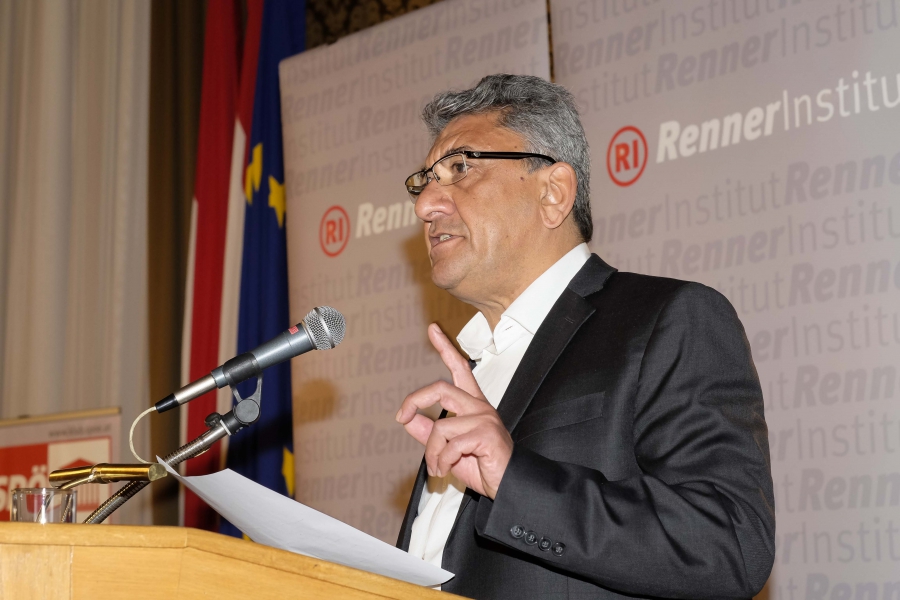 ©Peter Henisch
©Peter Henisch
Meine sehr verehrten Damen und Herren, liebe Freundinnen und Freunde,
an einem sonnigen Wintertag, der mit seinem silbrigen Licht jedoch eher einem Herbsttag ähnelte, erreichte mich mitten in Manhattan/New York die Nachricht von der Entscheidung der Jury. Sie können sich kaum vorstellen, wie beeindruckt ich war. Die Nachricht machte mich regelrecht sprachlos vor Freude. Nicht nur, weil sie so überraschend kam, oder weil ich gerade auf einer ganz ungewöhnlichen Reise auf der anderen Seite des Atlantiks unterwegs war, sondern vielmehr aus zwei anderen Gründen: Erstens, weil sie nach einem Reisetag kam, der ganz im Zeichen des ausgezeichneten Romans gestanden hatte. Ich bereite nämlich gerade dessen Fortsetzung vor und war in New York, um der Stimmung des Buches nachzuspüren, und dazu musste ich unbedingt Fort Meade in Maryland, 200 km von New York, besuchen, diesen Militärstützpunkt und Sitz der ebenso gefürchteten wie undurchsichtigen NSA. Hier fand auch der Prozess gegen Bradley – jetzt Chelsea – Manning statt. Wer den Roman gelesen hat, weiß, dass der frühere Marines-Angehörige, der einst in Bagdad diente und später der Webseite Wikileaks Hunderte von Dokumente zuspielte, dank derer wir heute wissen, welche Verbrechen die Marines im Irak begangen haben, nicht nur ein Name ist, der den Untertitel des Romans ziert. Ohne ihn wäre der Roman ganz anders ausgegangen als er es tut.
Eine wahrhaft abenteuerliche Reise, bei der meine Weggefährtin im Wagen am Kontrollpunkt am Eingang zum Stützpunkt nicht wenig Mut bewies. Dafür gebührt ihr meine aufrichtige Anerkennung, ich ziehe den Hut vor ihr, auch wenn wir letzten Endes doch nicht in die Festungsstadt hineinkamen, weil dies nur deren etwa 100 000 Bewohnern gestattet ist, die fast alle für die NSA arbeiten. Selbst das Museum, das uns gegenüber den schon vom Anblick her furchteinflößenden Wachleuten als Vorwand für unseren Besuch diente, selbst das Museum also, das wie alle anderen Museen dieser Welt eigentlich öffentlich zugänglich sein sollte, darf man nur betreten, wenn einer der Bewohner der Festung sich für einen verbürgt. Stellen Sie sich das also einmal vor: Diese gescheiterte Reise fand am 12./13. Dezember 2014 statt. Und just am nächsten Tag erfuhr ich im Apartment 5f in der 25. Straße in Manhattan von der Entscheidung der Jury. Wie sollte es mir da nicht die Sprache verschlagen?
Noch verwunderlicher jedoch war es, dass ich mich nur zwei Stunden später mit Annie Kelemen verabredet hatte, einer alten Dame, die ebenfalls eine Geschichte hat, die sich mit meiner überschneidet. Am 13. Mai 1939 wurde sie mit 14 Jahren zusammen mit anderen jüdischen Kindern mit dem letzten Kindertransport von Wien Westbahnhof nach London gebracht und entging so dem sicheren Tod in einem der Vernichtungslager der Nazis, in dem ihre Eltern umgebracht wurden. An dem Tag sah sie ihre Eltern zum letzten Mal. Annie ist eine Bekannte der Mutter meiner Reisebegleiterin und hatte soeben ihren 90. Geburtstag gefeiert. Sie würde mir stolz erzählen, dass sie sich für die Menschenrechte einsetze und nur ein Ziel vor Augen habe: Die Befreiung einer Marines-Gefangenen, die völlig isoliert in Einzelhaft gehalten werde, ohne Computer, Radio, Zeitung und Fernsehen. Über ihre Briefe befinde der Zensor und sie dürfe nur zweimal wöchentlich ihre Zelle für zwei Stunden verlassen. Ihr Name sei Chelsea Manning oder so ähnlich. Dann breitete Annie vor uns auf dem Tisch des Restaurants „Il Posto“, 2nd Avenue/Ecke 18th Street, Flugblätter aus, die „Freiheit für Manning“ forderten – ohne zu wissen, dass der, der ihr da lächelnd zuhörte und sich dabei leise zumurmelte „noch mehr miteinander verwobene Geschichten“, kein anderer war als der Autor eines Romans, der gerade zwei Stunden vor dem Treffen mit dem Kreisky-Preis ausgezeichnet wurde. Und dass es sich bei diesem Roman de facto um eine Hommage an diese Gefangene, früher Mann, jetzt Frau, handelt, für deren Freilassung sie sich einsetzt- was für ein Zufall!
Seit dem Augenblick, an dem an jenem sonnigen Dezembertag die Sonne Kreiskys aufging über den Fensterfronten und Hausdächern New Yorks, überlege ich, was mich eigentlich mit diesem Mann verbindet, dass ich diesen Preis genau zu diesem Zeitpunkt erhalte? Ja, mein Leben ist eine Reihe von Überschneidungen, wenn wir wie Musil einmal das Wort Zufall vermeiden. Doch welche Überschneidungen verbinden mich mit einer solchen Größe wie Kreisky?
Nachdem ich von dem Preis erfahren hatte, nach der Freude, der Hochstimmung, auch der ersten Aufregung, nachdem ich Annie zum Abschied noch einen Brief an Manning in die Hand gedrückt hatte, den ich im Restaurant geschrieben hatte und in dem ich ihr mitteilte, dass sie nicht alleine sei und dass ein Iraker einen Roman verfasst habe, der ihren Namen trage und dass eben dieser Roman soeben mit einem Preis ausgezeichnet worden sei, der wiederum den Namen eines Mannes trage, der sich unermüdlich für den Frieden einsetzte, nach all dem kam ich endlich langsam wieder zu mir. Ich begann langsam, Puzzlestücke von Informationen zusammenzusetzen, um mir ein Bild von Kreisky machen zu können. Natürlich war mir, wie jedem in meiner Generation, Kreisky an sich ein Begriff. Er war ja ein stetiger Vermittler im arabisch-israelischen Konflikt, ein Freund der Palästinenser, der erste überhaupt, der zu einer Zwei-Staaten-Lösung mit einem israelischen und einem palästinensischen Staat aufrief, die sich gegenseitig anerkennen und in Frieden miteinander leben würden. Natürlich war das eine reine Utopie, doch genau die Kraft dieser Utopie war es, die ihn zu einem verlorenen Symbol für den Frieden in unserer Region machte.
Doch nun wollte ich ein umfassenderes Bild von ihm entwerfen, auch von seiner Jugend. Mir war er ja erst als sechzigjähriger Kanzler aufgefallen. Was mir zuerst ins Auge stach, war seine Verhaftung 1936 aufgrund seiner politischen Aktivitäten gegen das Austrofaschistische Regime. Damals war er 25 Jahre alt und wanderte für ein Jahr hinter Gitter. Ich versuchte, mir ihn vorzustellen, im Gefängnis und auch in der Zeit davor, als politisch aktiven Oberschüler. Und anstatt gleich an mich selbst zu denken, der ich ebenfalls meine Laufbahn als Aktivist gegen ein nationalistisch-faschistisches Regime begonnen hatte, als ich in der Oberschule war, fiel mir zunächst ein anderer junger Mann ein, nämlich Hans Scholl, der bei seiner Verhaftung gerade einmal 23 Jahre alt war. Zwei mutige junge Männer, die der Diktatur Widerstand geleistet hatten. Kreisky hatte dabei das Glück, dass die Armeen Hitlers Österreichs Anschluss noch nicht vollzogen hatten, sonst wäre es ihm ergangen wie Scholl und seiner drei Jahre jüngeren Schwester Sophie: Hinrichtung durch das Fallbeil. War ich selbst nicht auch 23 Jahre alt gewesen, als man mich in die Folterzellen der Ba´th-Partei und damit eines Diktators geworfen hatte, dem bei seinem Sturz niemand auch nur eine Träne nachweinte?
Scholl wurde umgebracht. Die anderen beiden jungen Männer, Kreisky und Wali, dagegen überlebten und gingen ins Exil, um von dort aus weiter gegen die Diktatur zu kämpfen. Um ihren gefesselten Mitbürgern eine Stimme zu verleihen. Alle meine Romane, alle meine miteinander verwobenen Erzählungen, habe ich im Exil verfasst, Sprachen dort gelernt. Die Diktatur sah das Exil als Strafe an, doch wurde es für mich stattdessen zu einem fruchtbaren Feld für neue Schöpfungen, einem offenen Roman-Projekt. Und tat Kreisky nicht genau dasselbe? Das Exil bot ihm Raum für Aktivitäten und einen Entwurf der Vision für das Österreich der Zukunft. Achtzehn Jahre nach der Vertreibung der Nazis übernahm er das Außenministerium und ein Vierteljahrhundert nach dem Ende Hitlers verwirklichte er seinen Traum und wurde Kanzler Österreichs. Politik war ihm ein Projekt, eine offene Vision, er arbeitete an einem neuen Österreich. Kann man sich dieses Land heute überhaupt ohne die Leistungen dieses Exilanten vorstellen, der voller Hoffnungen zurückkehrte?
Doch halt – Kreisky war keineswegs nur ein Mann der Politik. In seinem großartigen, 1954 erschienenen Roman „Zeit zu Leben und Zeit zu Sterben“ erzählt ein anderer Friedensaktivist, der Mann, der den Grundstein für die moderne, antimilitaristische Weltliteratur legte, der Osnabrücker „Sohn des Westfälischen Friedens“ Erich Maria Remarque, die Geschichte von Ernst Graeber, einem 23 Jahre alten Soldaten, der im Frühling 1944 auf Heimaturlaub von der Ostfront nach Berlin kommt. Es ist das letzte Kriegsjahr, alles liegt in Schutt und Asche. Sein Elternhaus steht nicht mehr. Graeber zieht ziellos durch Berlin und trifft zufällig auf Elisabeth Kruse, ein jüdisches Mädchen, dessen Familie von der Gestapo ermordet wurde. Auch sie irrt durch die Trümmer Berlins. Die beiden verlieben sich, nachdem die Zerstörung sie zusammengebracht hat und beschließen zu heiraten. Wie bitte? werden jetzt einige fragen. Der Krieg tobt doch noch. Und da fällt dir, Graeber, nichts anders ein als zu heiraten? Ja, genau darum geht es im Kern. Stellung beziehen. Signale setzen. Bomben fallen auf Berlin. Hitler schart seine jugendlichen Standartenträger um sich, ein blutiges Terrorregime wütet voller Zerstörungswut – und Graeber will heiraten! Peter Weiß, ein weiterer Friedensaktivist und Zeitgenosse Remarques und Kreiskys, der Kreisky ganz sicher in ihrem gemeinsamen Exil in Schweden begegnete, würde das Verhalten Graebers mit Sicherheit als „Ästhetik des Widerstands“ bezeichnen. Und zu Recht. Graeber, den wie den Soldaten Daniel Brooks aus Bagdad Marlboro ein schlechtes Gewissen plagt, sucht Antworten bei seinem früheren Professor Pohlmann.
Und wissen Sie was?
Seitdem ich die Nachricht von der Preisverleihung erhalten habe, denke ich, dass dieser imaginäre Professor aus Remarques Roman, mit all seinen weisen Urteilen, seiner unerschütterlichen Haltung, seiner Wahrheitsliebe, keine imaginäre Person mehr ist, wie ich noch glaubte, als ich den Roman in den Siebziger Jahren zum ersten Mal las. Nein, seit dem 14. Dezember 2014 steht er mir ganz deutlich vor Augen. Es ist kein anderer als der weise alte Kreisky mit seiner fortschrittlichen Politik, seinen klugen Gedanken, an den wir uns immer noch ratsuchend wenden, so fern er heute auch scheinen mag. Meine Wiener Weggefährtin erzählte mir, wie er für sie, die keinen Vater hatte, zu einem zweiten Vater wurde. War er im Fernsehen zu sehen, freute sie sich wie ein Kind und wie oft hielt sie vor dem Einschlafen stille Zwiesprache mit ihm!
Jetzt werden Sie sagen: Ach, da kommt nun dieser Wali mit noch so einer von seinen verwoben-verworrenen Geschichten daher, der saugt sich doch was aus den Fingern und zeichnet uns zwei ganz verschiedene Bilder von Kreisky: eines als junger Mann, als Seelenverwandter von Hans Scholl, und eines mit dem Bezug zu Pohlmann, Remarques Professor! Ich kann nur erwidern: Aber warum denn nicht? Freiheitskämpfer wie Kreisky leben überall auf der Welt verstreut, zu verschiedensten Zeiten an verschiedensten Orten und gehören unterschiedlichsten Ethnien, Nationen, Hautfarben und Religionen an. Männer und Frauen, die der Geist der Freiheit eint. Sie kämpften gegen das Böse, gingen ins Gefängnis oder ins Exil, manche kamen dabei auch um, und sie sind nicht sehr zahlreich, doch sie gehen in das Gedächtnis der Menschheit ein. Heute toben allerorten zermürbende Kriege. In Nahost, Afrika, vor den Toren Europas, allerorten werden die Kriegstrommeln gerührt. Alle rufen zum Waffengang auf, betreiben Kriegshetze, auch Schriftstellerkollegen. Die Stimmung erinnert an den Ersten Weltkrieg. Manche prangern das offen an, andere lehnen sich untätig zurück. Wie sehr brauchen wir in diesem Schlachtgetümmel Friedensaktivisten vom Schlage Kreiskys!
Noch eine Geschichte, die letzte. Sie trug sich also folgendermaßen zu: Vor einem Jahr stellte ich zufällig fest, dass die Werke Goethes gar nicht aus dem Deutschen ins Arabische übertragen wurden. Ausgerechnet der Verfasser des „West-östlichen Divan“, dieser Sammlung von Reimgedichten, zu der er sich von den Werken des persischen Dichters Hafis inspirieren ließ, also Goethe, dessen Divan eine Mischung aus westlicher und nahöstlicher Kultur, deutsch-persischer Sprache und islamisch-christlicher Religion darstellt, ja, der sich sogar für die vorislamisch-arabische Dichtung, insbesondere die sogenannten al-Muallakat, interessierte – alle seine ins Arabische übersetzten Werke wurden aus dem Französischen übersetzt! Was für eine Ironie! Als ich in Wikipedia nach Kreiskys Biografie suchte, stellte ich fest, dass sie in 38 Sprachen verfügbar war, mit Ausnahme von einer Sprache: Arabisch. Ausgerechnet für diesen Freund der Araber, einen der ersten Politiker weltweit, der sich für eine gerechte Lösung des Nahostkonflikts einsetzte, gibt es keinen Eintrag auf Arabisch? Liegt das wohl daran, dass er jüdischer Herkunft ist? Oder daran, dass, wer zum Frieden aufruft, zu einer Zwei-Staaten-Lösung, Kriegstreibern und rassistischen Hetzern ein Dorn im Auge ist?
Bei meiner letzten Reise nach Baltimore, das laut den Statistiken der amerikanischen Bundespolizei aufgrund der Bandenkriege unter den Drogenkartellen die achthöchste Kriminalitätsrate unter den Städten in den USA aufweist – seltsam genug für eine Stadt, die nur wenige Kilometer von Fort Meade und der NSA entfernt liegt!- in Baltimore also, das mit seinen verlassenen Vierteln einer Geisterstadt gleicht, stößt man im Norden der Stadt, im Universitätsviertel, auf das „Red Emma’s“, eine idyllische Oase des Friedens, eine Bistro mit angeschlossener Buchhandlung und Veranstaltungsraum, in dem allabendlich Lesungen stattfinden. Dank Google erschließt sich leicht die Biographie der „Roten Emma“, dieser Anarchistin, die seinerzeit ganz Amerika mit ihrem Kampf in Aufruhr versetzte. Ein Satz von ihr ist mir ganz besonders im Gedächtnis geblieben, dessentwegen ich Ihnen auch diese verwobene Geschichte so ganz ohne Vorwarnung überhaupt aufgetischt habe. Das Zitat lautet: „Es gibt keine größeres Verbrechen als Ignoranz“. Schauen Sie einmal mit mir: Jetzt versucht man auf Arabisch, das Andenken Kreiskys auszulöschen. Die Sprache einer der beiden Konfliktparteien ignoriert ihn. was für ein Verbrechen! Wie in den griechischen Tragödien ergibt sich laut Aristoteles die Philosophie des ironischen Dramas nicht aus den Schwächen in der Persönlichkeit des Protagonisten, sondern gerade aus seinen Stärken. Die Menschen geraten nicht wegen ihrer Fehler in ein Dilemma, sondern wegen ihrer Vorzüge. Die Ironie des Schicksals ist es doch gerade, die die Tiefe der Persönlichkeit in unseren Augen stärkt, genau anders, als was diejenigen annehmen, die sie für ihre Vorzüge abstrafen!
All das sind mit einander verwobene menschliche Schicksale. Kann man es mir da verübeln, wenn ich nicht geradlinig erzähle, sondern immer verwoben und verschlungen, so dass manchen vor Verwirrung ganz schwindelig wird? Erinnert Sie das nicht an einen Lieblingstanz aus Kindertagen, den Walzer? Eine Leserin schrieb mir vor einigen Tagen, ohne zu wissen, dass ich in der Hauptstadt des Walzers Wien eine Rede halten würde: „Am Ende sah ich Sie als Tänzer, der mich zum Tanz aufforderte und von dem ich mich davonführen ließ. Ich denke hier an einen Walzer, wie ich ihn in meiner Kindheit und Jugend liebte, kein geradliniger Tanz also, sondern voller Drehungen und schleifender Schritte. Er versetzt in taumelnde Ekstase und die Tänzerin muss den Tänzer dazu ganz sicher mögen. Er dagegen muss den Tanz vollständig beherrschen, so dass beide sich diesem hingeben können. Und da man ja während des Tanzes den ganzen Saal der Länge und Breite nach durchkreuzt, lernt die Tänzerin den Raum gut kennen, so als begebe sie sich in eine bildliche Mediation oder vermesse die Fläche. Genau so erging es mir beim Lesen Ihres Buches. Ich denke jetzt, da ich Ihnen diese Zeilen schreibe, daran, wie ich während der Lektüre nicht innehalten konnte, und kann behaupten, dass ich Sie und Ihr Land vom Gefühl her so kennengelernt habe wie Walzertänzer einen Saal. Sicher, Jahreszahlen, Namen und Ereignisse sind mir nur verworren in Erinnerung geblieben, doch das ist nicht weiter wichtig, denn schlussendlich kann man auf der anderen Ebene viel mehr begreifen als über den Kopf.“
Der Walzertänzer verneigt sich nun vor Ihnen, es war dies seine letzte Drehung heute Abend hier mit Ihnen. Ich danke der Jury nochmals: es ist so wunderbar, dass Ihre Wahl auf mich gefallen ist. Dieser Preis ist für mich und meine Werke nicht nur Ehre und Anerkennung, sondern vor allem Anreiz und Auftrag, weiterzuschreiben, mich weiter für Völkerverständigung und Frieden einzusetzen.
Und auch eine Gelegenheit für mich, gut Walzer tanzen zu lernen, wenn Sie gestatten?
Aus dem Arabischen von Nicola Abbas

